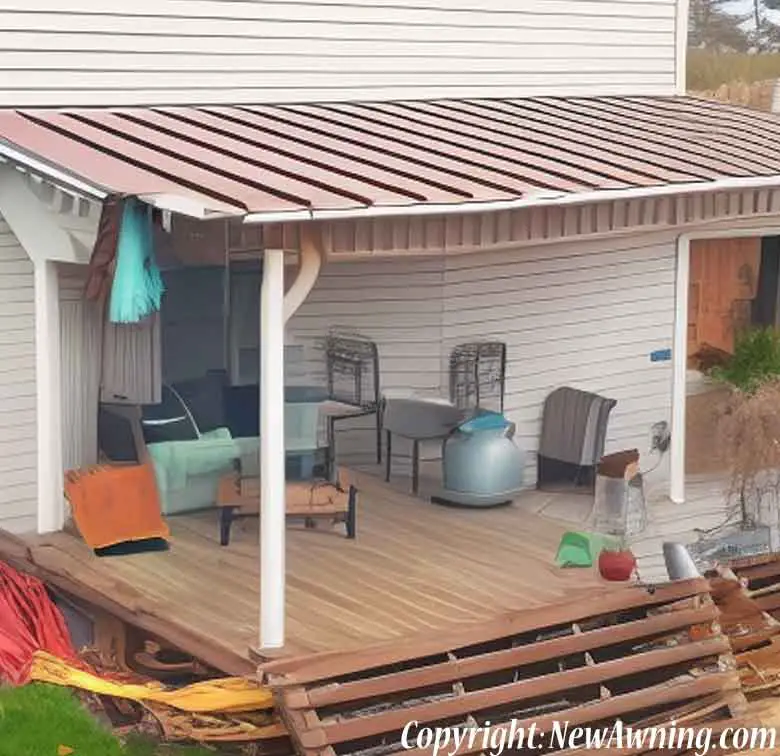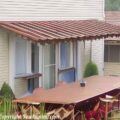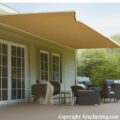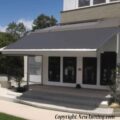Last Updated:July 22, 2024
Awning Cleaning Complete Guide

Awnings are important additions to RVs such as motor homes and caravans. They add floor space to a motor vehicle parking thus giving a rich shade and personal space at any time of the year whether in the rain, in snow and hot temperature. An awning provides a perfect shade that protects the summer heat. The major types of awning include retractable and the fixed awning which is based on the kind of material used and the style used. An awning that is fit is usually good since it is stable and can work better in weather protection.
Retractable awning, on the other hand, can move, and it is easier to open or close, therefore, offers several choices and is convenient.
It is important to thoroughly clean an awning to prevent against the build up of debris, mold, bird droppings and mildew because they can lead to deterioration. Dirty awnings take away the appeal of a home curb. Awning cleaning involves a fast and easy process, although on needs to climb a ladder.
Gather your Supplies to Clean your Awning
We’ve created a handy checklist of all the items we use when cleaning our awning. This checklist will save you time by getting everything outside on the patio before you begin. There’s nothing worse than pausing cleaning to tromp through the house with wet feet because you forgot a sponge or the broom.Also, don’t worry if you don’t have all the items on our list. All the items with an * are something we consider mandatory while everything else is optional. The latter items will make cleaning go faster, but they’re not not required.
- Garden Hose*
- TWO 5 Gallon Buckets*
- Soft Bristle Brush*
- Long Handle Brush
- Large Sponge*
- Broom*
- Towel*
- Cleaning Agents(As appropriate for your specific fabric)*
- Safety Glasses*
- Vacuum Cleaner
Check for Any Holes or Tears in Your Awning
Before you do any cleaning, the first step is look at the entire canopy for any holes or rips. If you find one of these, you should repair the awning before doing any further steps. There are several methods of repairing a hole depending on the size, and tears/rips can be addressed with awning tape.We created a full guide on awning repair if you find something. (link) If you try to clean the awning with tears or holes, you risk ripping the fabric more which will only make the issue worse.
Sweep Off the Awning
You will want lightly sweep off any dust, debris, cobwebs from the awning. This includes the topside of the canopy, the underside, and especially in the metal frame. The frame is a favorite hiding spot of spiders so you’ll want to be careful using the brush to move any spiderwebs rather than your hand.Dust and dirt can settle on the fabric of an outdoor canvas or vinyl material which will make it more difficult for you clean with water.
You’ll need a broom that is long enough so you can get underneath, but not too wide in case there are holes where dirt gets caught. We use a standard kitchen broom that picked up from Walmart for $4, and it’s worked perfectly for years.
Spray Off the Top Side of the Awning Canopy
The next step is use the garden hose to liberally spray water all over the top of the canopy. The hose should be on medium pressure. I always start low pressure and increase it as I’m cleaning to make sure that I’m not going to damage the fabric.I prefer to start at the top left corner and spray left to right moving down a row like reading a book. This ensures that water cascades over the lower part of the awning many times.
Once the entire surface is wet, and the only thing left are the stubborn stains, you’re ready to move to the next step.
Mix The Water and Cleaner
If you’re awning manufacturer has recommended specific cleaner use that. If you don’t have that or don’t know, we recommend using dawn dish washing liquid. About the same ratio as you’d use for washing your car. One tip is that I get warm water from inside our home rather than using the water from the hose.This is not hot water as it should not burn your hand, but rather warm. The warmer water will make it easier to remove the stains on the awning. This warm soap water solution goes in the first bucket.
The second bucket you can spray water from your garden hose. This will be your rinse bucket that you clean your brush off in.
We fill each bucket up about halfway, and if you’re rinse bucket gets dingy feel free to empty it and replace with clean fresh water. You always want to keep the soap bucket and brush clean so that you’re not reapplying the grime and gunk back to the awning surface.
Brush The Top Side of the Awning
If you have a long handle brush, you can easily do this from the ground. We sprung for a long-handle brush, and it makes our cleaning go so much faster and easier.I hated the other two options of taking down the shade or climbing on a ladder. Using a long-handle brush took this to a chore that I don’t really mind, and cut the cleaning time by more than half. Here’s a link to our favorite long handle brush.
The key is to brush over every inch of the fabric even if it looks perfectly fine. You don’t wan to apply a lot of pressure, but lightly going over the fabric with soap water is going to get rid of the bacteria. This will cut the likelihood of mold or mildew growing.
If you have mold or mildew you will want to brush with more pressure. Just take care not to rip the fabric. Also, check with your manufacturer what cleaner would be best and safest to eliminate the mold or mildew.
Warning: Several guides recommend using bleach water to remove the mold/mildew, but this is not a universal solution. The bleach water will discolor some fabrics which will create a light spot or even completely white spot on your awning.
Spray The Awning to Rinse off the Soap
With all stains, mold and mildew spots removed from the top of the awning, spray the topside of the awning. As before start at the top working left to right, and you’re free to stop once all the soap has been washed from the awning.Spray the Underside of the Awning
This is very like the first spraying of the topside. The goal is just to remove the dust and debris. If you grill or BBQ under your awning, you may need to look for grease spots or marks left from smoke. The dawn solution is great for removing the grease stains.When you’re spraying the underside of the awning, you’ll need to hit every inch with the hose. The water won’t roll down the underside the same way it will on the top. As such, you’ll need to spray more water to get it fully wet.
Brush the underside of the awning
If you have a hand held brush or sponge, I’d recommend using that. The awnings are normally hung at a height that it’s possible to fully reach the underside by just cleaning over your head.If you don’t have a hand held brush, you can choke up on the long-handle brush and use it that way. Just make sure the handle is facing away from the home as you don’t want to accidentally break a window.
As a note, I wear safety glasses from start to finish, but they are essential at this point. You don’t want something to fall into your eye while your cleaning since you’re standing underneath the awning.
Rinse the underside of the awning
With your garden hose, generously spray the underside of the awning to remove any soap. I am always incredibly liberal with water here as I don’t want to leave any soap residue on the underside of the canopy.Dry the Awning
With the towel, you will want to full dry the top and underside of the awning. This will lower the chance of developing mold or mildew. You do not want to press too hard when you’re drying the awning.If you have a long handle brush, you can place the towel on that and use it to dry the top of the awning.
Every second cleaning, we apply a waterproof sealant to the fabric. This not only seals the clean fabric away from the elements. It repels rain water lowering the chances of getting mold or mildew. It also makes the fabric more resistant to getting stains.
Conclusion
That’s our complete guide on “How to clean your awning”. The intended audience is homeowners. If you are a business, you should plan to clean your awning several times per year. For businesses like restaurants, we recommend at least every 60 days. This goes for any awning that will be close to the customers, or that it will see heavy use.The average homeowner only needs to clean their awning once or at most twice a year.
We love helping our readers with their awning question. Also, if you have any tips you’d like to share with our other readers, feel free to tweet us @newawning .
Step 1: Expose the entire Surface
Cleaning and maintenance of any awning begin by taking this basic step. It is not easy to clean an awning while it is folded up; therefore it requires setting it up to spread the material and allow all areas to be exposed correctly. Cleaning unfolded awning will not allow proper drying up, and this might cause the growth of fungi and mold on the awning material. Awnings are made of waterproof materials, and therefore it is essential to allow the fluids to dry up or wipe it thoroughly. An easy way of cleaning an awning is to select a day that is sunny, and the rest of the work will be done because the sun will help the awning material to dry up.Step 2: Removing the Grime
Accumulation of grime is majorly the primary concern to many awning owners. Grime consists of debris, dirt, bird droppings and any other droppings that accumulate on top of an awning. Awnings grime should be cleaned as soon as possible to avoid damaging. The awning material is easily damaged if the water is left for an extended period. Therefore it is important to wash away any grime to avoid making the awning dirty.Step 3: Using Water and a Soft Cloth
The easiest tools for cleaning an awning are water and a soft cloth. The two tools are simple to use thus have been proved to be the most effective. The idea is a good one since primarily an awning is made of caravans thus making it waterproof. The waterproof ability of an awning material is not easily affected when water and soft cloth are used during the cleaning process. While cleaning an awning, one should always use a light hand because using bold strokes damage the awning material. However, in the case of stacking of debris on the cleaning cloth, then scratches can be made.Step 4: Use of Every Day Cleaners
In the market, there are several standard issue cleaners for awnings. It is advisable to contact the manufacturer of an awning to get professional advice on the most compatible filter to use. Contacting the respective manufacturers gives one the necessary boost for an efficient and faster way of cleaning an awning thus does not compromise the effectiveness of the awning material.For most awnings, you are safe to use Ivory or original dawn dish detergent. You will want to dilute the soap in a bucket with luke warm water and scrum the dirty areas with a soft bristle brush. Once you have washed the area, you will want to liberally rinse the area by spraying it with a low pressure garden hose. After the rinse, allow the awning to air dry. You will want to towel off any pools of standing area, and you never want to retract a wet awning as it can lead to mold or mildew.
Step 5: Final Touches
An excessively dirty awning may require the use of bleach mixed in warm water for an effective removal of dirt. The process makes it easier when it comes to cleaning grimy awnings.Frequently Asked Questions
How do I clean mold or mildew on an awning?
We recommend creating a adding 1/2 cup of vinegar to 1 gallon of distilled water. After thoroughly mixing, apply it to the trouble area with a soft bristle brush and allow to stay on the surface for 2-3 hours before rinsing with a garden hose. If the mold or mildew remains, you may need to use a bleach mixture; however, only do this after getting information from the specific manufacturer. Some fabrics will have their color distorted or eliminated entirely if the bleach is overdone. This should be done only as a last resort.How do I clean oil on an awning?
This is one of the easier stubborn stains to clean. You can use acetone on the area. After applying the acetone, allow it to stay on the surface for 10 minutes and then gently wipe it off with a cloth or soft bristle brush. If the oil leaves the fabric, then you can merely spray the area with a hose. If it remains, you need to apply more acetone to the area.How often should I clean an awning?
We recommend cleaning once every three months in use and to always do a thorough clean if you are going to take it down and store it for the winter.Is there a DIY or homemade awning cleaner?
We use 1 cup of dawn dish detergent with 1 gallon of distilled water?Why distilled water?
There are two reasons for distilled water. The first is tap water will have a small amount of minerals. If you have hard water or iron in your water, this can lead to staining in some fabrics. The second reason is that distilled water has a neutral pH level. Using water that is neither acidic or alkaline will eliminate the risk of interacting with the dye used to generate the canopy’s color.What’s the best commercial awning cleaner
We love Trinova protectorant. It costs around $15 per bottle, and the bottle will last several years worth of cleanings. It super strong, and we’ve never heard of it damaging anyone’s shade structure.How should I clean a damaged/discolored awning?
This is a bigger question, and we’ve created a full guide on awning repair here.Any videos showing awning cleaning? We found one on Youtube we really like that you can view below.





